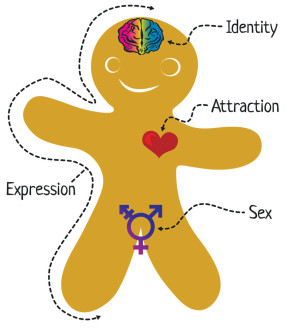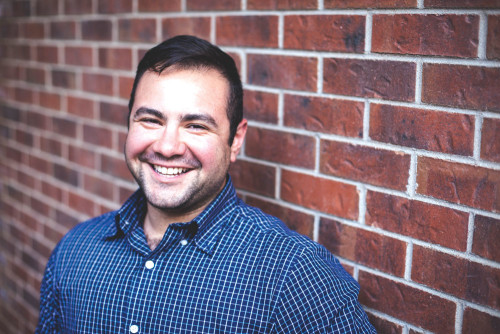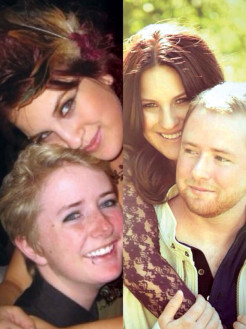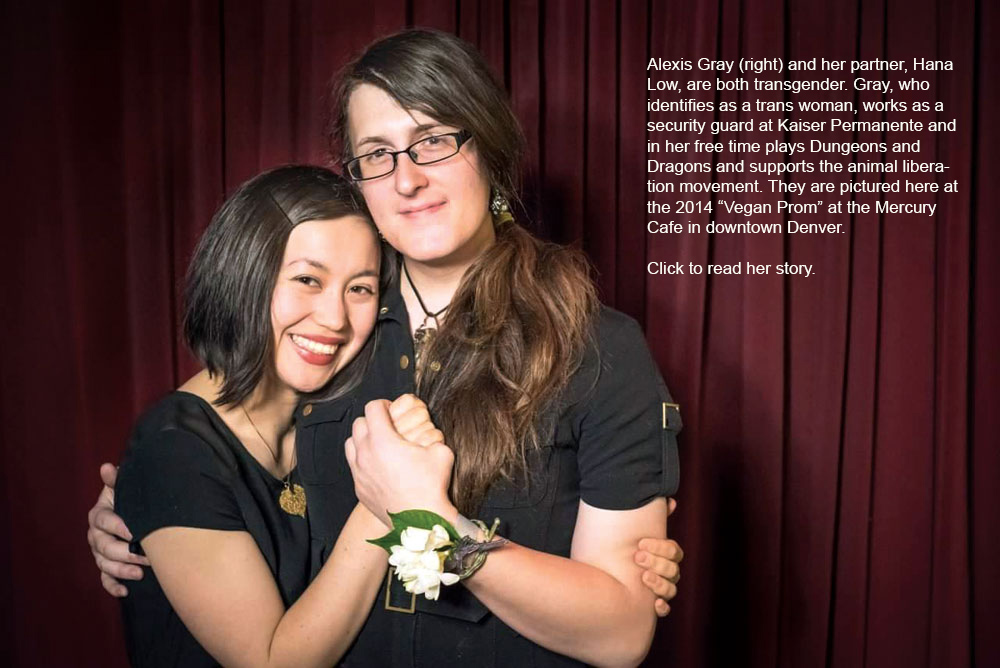Americans love binaries—placing things into one of two categories. A person is either rich or poor, black or white, man or woman. These categories make sense to the people who fit into them, where they are naturally more comfortable than in the gray areas of the unknown. But it turns out, many binaries are not really binaries. Many people do not clearly fit into one category or another. The people in-between, though often invisible, need and want to be understood. These gray areas have always existed, but have taken longer to make it into the public sphere and become accepted. In the past couple years, an intriguing, complicated world has emerged from the gray: gender identity.
“Everybody gets afraid when tradition changes. There is a thing in all humans when we allow ourselves to think this is the way we should be and how humans should always be, but things should change. As time goes on, we should continually reexamine things,” says Alexis Gray, north Denver resident.
Gray, having an ironic last name, lives in one of the gray areas. Here is a snapshot of her life and just how complicated gender (and gender vocabulary) is:
She lives in the non-binary and is a trans woman from a cisgender family. She presents femme but doesn’t try too hard to pass. She is dating Hana Low. Like Gray, they are also transgender, but gender queer and chooses to present mostly femme…
Did that all make sense? Did it sound grammatically incorrect at parts? It’s accurate and real for Gray and Low.
People have typically understood or even been taught that if a person is male, he is a man, acts masculine, and is typically attracted to women, just as a female is a woman who acts feminine and is attracted to men. This type of thinking lumps gender, sex and sexuality into one category, yet these aspects of identity are independent of one another.

Gender is one of those things everyone thinks they understand, but most people don’t. Click on this graphic to read a guide to gender understanding.
Chromosomes, hormones, body shape and hair, gonads, internal organs and genitalia determine a person’s biologic sex. It is assigned at birth and is either male or female, unless a baby has a disorder of sex development, previously called intersex, when something unusual occurs during the sex development phase in the fetus. These babies can have missing or extra sex chromosomes, hormone abnormalities and ambiguous genitalia. A person’s gender or gender identity is how a person identifies—as either a man or woman. Gender expression is how a person chooses to show that gender, whether it’s with clothes, voice, interests, whatever. Sexuality is who a person is attracted to. Each of these is a separate continuum in which people can fall at any point. Making the distinctions can be puzzling, even for the most curious and sympathetic bystander.
Most people are cisgender, or identify with the sex assigned at birth. Transgender is an umbrella term for anyone whose sex at birth is different than how they know themselves to be. A person born male may really feel he is a woman, or vice versa. Transsexual is pretty out of date but generally refers to someone who has had surgery or hormones to align his or her body with the gender he/she identifies with. Trans is the most common term. A trans woman was born as a male but identifies as a woman. A trans man was born a female but identifies as a man. A person may show signs of transgender as early as three or four, or a person can figure it out at 65. It’s different for every individual, and when they choose to share their identity with others will be different for each person.
But also—another layer in the mix—a person may identify as neither male nor female, known as gender queer, agender or gender fluid, like Gray’s partner, Hana. They prefer the pronouns “they/them/theirs,” even if it doesn’t sound right to others. Again, gender: it’s complicated. (Really confused? Click here or on the Genderbread Person above)
The trouble is, the American world is built on the binary, so things are currently out of whack. Can a trans man serve in the military? Should women’s colleges accept trans women? Can a trans woman play in a sport generally identified for women, even though she may inherently be stronger and faster? Americans grapple with what it all means and how to even talk about it. Some think trans people have mental disorders and believe in conversion therapy to “help” them identify with their birth sex. President Obama has called for a ban on these therapies.
“I hope someday people will assume first, ‘Hey, this person is trying to get by in the best way that they can,’ rather than, ‘This person is the enemy and a pervert and we must keep them away from our children.’”
—Alexis Gray
![]()
Trans people are susceptible to harassment, violence and attacks in public spaces, and murder, with trans women of color facing the highest rate, according to Shanna Katz, PhD student and adjunct professor at University of Denver. Nine trans women have been murdered in the U.S. this year. The rate of attempted suicide among trans people is shocking—41 percent.
Katz advocates for LGBTQIA, the ever-growing acronym for lesbian, gay, bisexual, queer, intersex and asexual. She will be teaching a course about transgender studies at Metropolitan State University this fall. She explains many trans people cannot get jobs or access to healthcare, but one of the biggest and most basic concerns is using a public bathroom. Colorado State Senator Pat Steadman helped push the successful 2008 Public Accommodations Bill to allow people to use the bathroom of the gender they identify with. The bill faced huge criticism, with opponents claiming that trans women would go into the bathroom to go after little girls. “The fear mongering that goes on to perpetuate the ability to discriminate is astonishing,” Steadman says.
There is judgment even within the trans community, particularly about how a person chooses to pass, or fit into the gender they identify with. For some, transitioning means changing pronouns and dressing differently. For others, it means top and/or bottom surgeries, although bottom surgery is relatively uncommon due to lack of access. It is often not covered by insurance and costs many thousands of dollars out of pocket. Some also choose hormone replacement therapy. Collin Eagen describes that harrowing time: “You’ll be this ugly, chubby person and nobody can tell what gender you are and treat you so weird.” Then there are some trans people who choose not to transition at all—some can’t afford it, some don’t want to.

Leo Kattari, who identifies as a trans man, is the Health Policy Manager at One Colorado. Click to read his story.
![]()
For those who do transition, some are happy that they are lucky enough to pass; others do not respond as well to hormone therapy or prefer to live in the gray area. Caitlyn Jenner passes very well. She loves the glamor and sultry outfits and talks about the joy of painting her nails. Many feminists have criticized her overly girly presentation of what it means to be a woman. But if Jenner transitioned and wore grungy clothes and unkempt hair, she would likely be criticized for not being womanly enough. Trans people have to fit in the perfect area of that gender—and many don’t.

The right panel is a current photo of Collin Eagen and his partner, Ariel. Collin identifies as a trans man and gender queer and Ariel is cisgender and gender queer. Eagen is currently a marketing intern and competes in a dangerous equestrian sport called Three Day Eventing. Click to read his story.
Collin Eagen is a trans man and gender queer, meaning he was born a female and transitioned, now presenting as a male. But he doesn’t totally identify as being a man. Although he passes very well with a lot of body hair, he likes his feminine side and actively brings that out with brightly colored clothes and a higher tone of voice, which has caused him to be ostracized within the trans community. Many ask, why would you transition if you are going to act like a gay man? Upon first meeting Eagen and his partner, Ariel, whom he met as a lesbian at 17 (and they stayed together through his transition), people think they are a heterosexual couple. Then after hearing Eagen’s feminine speech, people think Ariel is dumb for marrying a gay man.

Sam Bullington is a women and gender studies professor at CU and identifies as transsexual. Click to read his story.
Clearly, things are not as obvious as they appear. The world of gender is not black or white—and it is getting increasingly complicated. With recent magazine covers featuring trans women Laverne Cox and Caitlyn Jenner, more and more people living outside the gender binary want to share their stories because, while any conversation about transgender is good, the trans community wants people to know there are immense differences from one person’s story to another. Laverne Cox and Caitlyn Jenner are different, and different than other trans people. Most trans people want to be heard and open up when asked about their lives. Scheduled half hour phone calls for this article turned into one- and two-hour conversations. Although people living in the non-binary world are all different, when they speak, they touch on many similar subjects: their family and perhaps losing them, their powerful bond with a partner, trouble with health care, fear of going to the bathroom, and searching for doctors. Their sexuality and gender identity may confuse or disturb some, but their values are familiar—to not be afraid to be themselves, to have a sense of belonging, and to live their lives free of judgment.




0 Comments